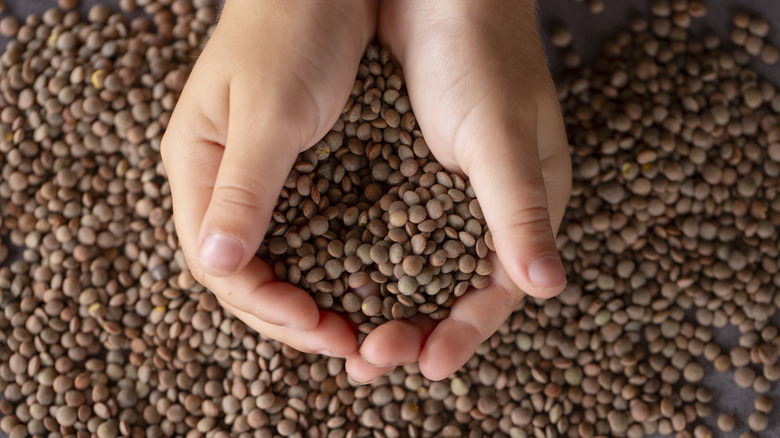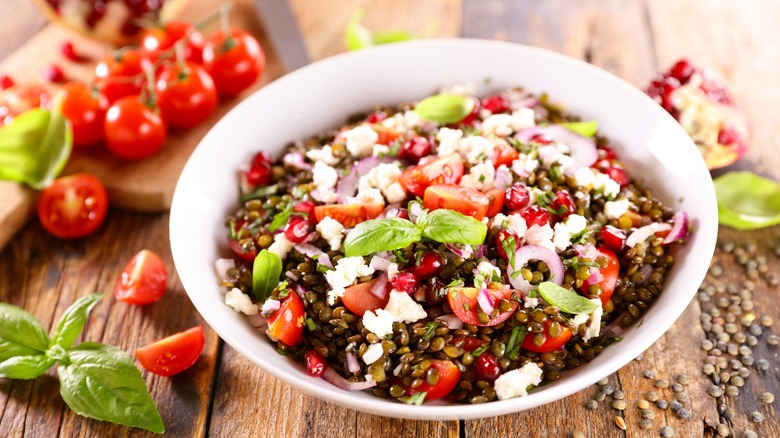The Simple Addition That Adds Tons Of Nutrition To Any Salad
Looking to upgrade that salad? If you're trying to be healthy and want to maximize your meals, we have just the trick. With one simple addition, you can add tons of nutritional value without compromising the flavor of your dish. In fact, this ingredient is so versatile it can be used in almost any salad. Plus, it's vegan and gluten-free to boot.
So what's our secret ingredient? Lentils. The nutty, earthy flavor of lentils complements a wide variety of salad ingredients, from leafy greens and veggies to fresh fruits and cheeses. However, lentils are still subtle enough that they don't overpower dishes. They have a chewiness that adds a nice textural element and a heartiness that salads often lack. Overall, adding lentils to a salad can help you feel more satiated. Salad no longer has to be a side dish; it can become the main attraction.
But if it's primarily nutrition you're after, we've got your back. To create a well-balanced, tasty dish, we've also included tips to incorporate lentils into different types of salads. Keep reading so you can enjoy a nutrient-dense, delicious salad right from the comfort of your home.
Nutritional benefits of lentils
Nutrition is a hot topic these days. People are becoming more aware of what they eat and how to get all the nutrients they need. Luckily, lentils are a nutrient-dense food, meaning they're packed with vitamins and minerals. A cup of cooked lentils has 230 calories, and within those calories, you'll find a healthy dose of protein, fiber, and many other nutrients.
For starters, lentils are protein powerhouses, packing 18 grams per cup. After a day of normal activity or a hard gym session, your body utilizes protein to piece everything back together, and hopefully make you even stronger. However, we recommend combining foods to get the most out of these nutrients. Lentils contain some of the essential amino acids your body needs, but they have to join forces with a grain to form a complete protein. Think quinoa, rice, or wheat.
Lentils also contain over 15 grams of fiber per cup. The USDA recommends people consume 28 grams of fiber in a 2,000-calorie diet. If that's your fiber goal, a cup of lentils will get you over halfway there. Fiber is also a highly important part of your diet since it helps you digest food and absorb nutrients, including the ones in lentils themselves. Lentils are an excellent source of potassium, iron, folate, manganese, and more. Honestly, we can't praise lentils enough. So if you're excited to add an extra dose of nutrition to your salads, check out our tips below.
Tips for incorporating lentils into salads
Did you know there isn't just one type of lentil? When you picture lentils in your head, you probably think of the common brown version. However, there are several lentil varieties, including red, green, or black ones. They're all nutritious, so choosing one should come down to availability, personal preference, and aesthetics. After all, a pop of orange-red legumes in a green salad is a feast for the eyes as well as the stomach.
Another thing to consider when adding lentils to salad is balancing flavors and textures. Salads don't have to be solely lettuce and dressing; you can get far more creative than that. Think crunchy roasted lentils mixed with spinach, quinoa, raisins, and crisp red onions. Or, enjoy the sweet and savory dance of cherries, lentils, and basil in this refreshing salad recipe. If you're craving a comforting dish, go for warm lentils over roasted veggies with a sprinkle of feta cheese.
Finally, you obviously can't eat lentils raw. They need to be cooked to be digested properly. You can buy precooked cans or boil the legumes at home. Alternatively, you can try sprouting your lentils. Plus, sprouted lentils add a fun crunch and pretty flair to any salad. Whichever option you choose, we recommend prepping your lentils in advance. This way, they'll be ready to go for your next salad.


